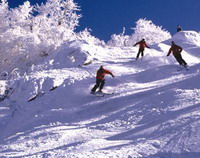Login form
New Hampshire

New Hampshire is known for its beautiful scenery. The rugged White Mountains in the north are especially scenic. Lakes dot the rolling countryside in central New Hampshire. Forests cover much of the state. In the fall, the leaves of maples and other trees turn shades of orange, red, and yellow. Many tourists visit the state in fall to enjoy the brilliant colors.
THE GRANITE STATE
New Hampshire is nicknamed the Granite State because of its large deposits of granite rock. The soil in New Hampshire isn’t very good for farming. It’s stony and lies over granite.
The “Old Man of the Mountain” was a famous sight in New Hampshire. The Old Man was part of a granite mountainside in Franconia Notch State Park. This bit of mountain looked like a human face seen from the side. The face fell from the mountain in a rockslide in 2003. However, the Old Man still appears on the New Hampshire quarter.
|
Facts About New Hampshire |
|
|
|
|
|
Capital |
Concord |
|
Population |
1,290,000 people |
|
Rank among states in population |
41st |
|
Major cities |
Manchester, Nashua, Concord |
|
Area |
9,350 square miles |
|
Rank among states in area |
44th |
|
Statehood |
June 21, 1788, the 9th state |
|
State nickname |
The Granite State |
|
Name for residents |
New Hampshirites |
|
State bird |
Purple Finch |
|
State flower |
Purple Lilac |
|
State tree |
White Birch |
|
Abbreviation |
NH |
WHITE MOUNTAINS
The White Mountains cross the northern part of New Hampshire. These heavily forested mountains are part of the Appalachians. New England’s highest peak is in the White Mountains. Mount Washington rises 6,288 feet (1,917 meters). You can ride a cog railway to the top. Several trails also lead to the top of Mount Washington, and cars can travel along a road.
Tourists head to the White Mountains for hunting, camping, hiking, and mountain climbing. In winter, the mountains are a popular place for skiing and riding a snowmobile.
SEACOAST AND PORTSMOUTH
The southeastern corner of New Hampshire meets the Atlantic Ocean. The state’s seacoast is short—only 13 miles (21 kilometers) long. There are sandy beaches along the coast.
Portsmouth, New Hampshire, is an Atlantic seaport and a tourist center. The town dates back to 1623, and it has many old houses. Strawbery Banke is a museum along Portsmouth’s waterfront. The buildings in Strawbery Banke show how people lived at different periods in American history.
GO BACK IN TIME
In many New Hampshire towns, you’ll feel as though you’ve gone back in time. The state has kept many wooden churches, grass-covered village greens, and homes from the 1700s. New Hampshire has 53 covered wooden bridges that date from the 1800s.
In Hillsboro, you can visit the home of Franklin Pierce, 14th president of the United States. The birthplace of statesman Daniel Webster is near Franklin. In one short story written about Webster, he is such a great lawyer that he wins an argument with the Devil himself! Near Derry, you can visit the farm where poet Robert Frost lived from 1900 to 1911. Frost wrote many of his early poems here.
CHOOSING A PRESIDENT
New Hampshire is a small state, but it has a lot of political power. Every four years, it holds the first U.S. presidential primary election. In the primary, people vote to choose the candidate of their political party.
People who want to become president must first do well in the New Hampshire primary. Winning this small state gives them an advantage later, when other states hold primary elections.
Before the primary, candidates flock to New Hampshire to shake hands and rally support among voters. Thousands of newspaper and television reporters follow them.
EARLY DAYS
New Hampshire was named by one of its earliest settlers, John Mason. Mason named it after Hampshire, the county he came from in England.
New Hampshire was one of the original 13 colonies. It became one of the first American colonies to declare independence from Britain on June 15, 1776. It thereby beat the Declaration of Independence by three weeks. In January 1776, New Hampshire became the first colony to set up its own government.
After the American Revolution (1775-1783), New Hampshire ratified (approved) the U.S. Constitution on June 21, 1788. It was the ninth state to join the United States. Concord is its capital. Manchester is its largest city.
MANCHESTER AND TEXTILES
Early in its history, New Hampshire depended on farming, logging, and shipbuilding. In the early 1800s, textile mills began to produce cotton in the state. Manchester became the center of textile production. The town had first been named Derryfield. In 1810, it changed its name to Manchester after a city in England that was an important textile center.
For many years, the Amoskeag Manufacturing Company in Manchester ran the largest cotton mill in the world. But Amoskeag went broke during the Great Depression of the 1930s. Today, factories in Manchester and elsewhere in New Hampshire make machinery, electronic equipment, computer software, and other goods.
LIVE FREE OR DIE!
New Hampshire’s official motto is “Live free or die.” John Stark, a Revolutionary War general from New Hampshire, wrote these words. “Live free or die” sums up New Hampshire’s commitment to independence.
Source: Microsoft ® Encarta

